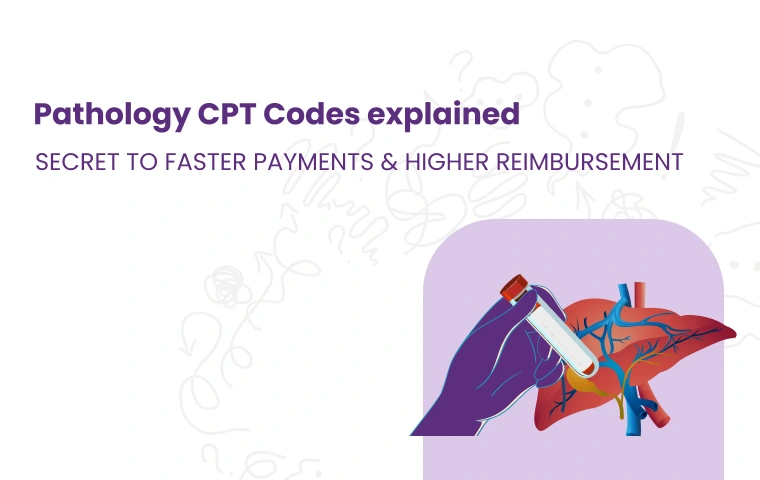Are billing errors and claim denials draining your revenue? Every year, medical providers lose thousands due to incorrect pathology CPT coding—leading to delayed payments, compliance issues, and lost revenue. The difference between maximizing reimbursement and facing claim rejections often comes down to using the right pathology and laboratory CPT codes.
From biopsy analyses to molecular diagnostics, every test and procedure has a specific CPT code that determines how much you get paid. Miss one detail, and you risk underbilling audits or outright claim rejections.
But, when done right, accurate coding ensures smooth reimbursement, faster processing, and compliance with medical billing regulations.
Pathology CPT Codes: A Closer Look
CPT codes (Current Procedural Terminology) are essential for standardizing medical billing and insurance claims. When it comes to pathology, CPT codes classify services based on the complexity of procedures, tissue examinations, and molecular analyses.
Why Accurate Pathology CPT Coding Matters?
-
Maximizes Reimbursement – Ensures you receive proper payment for diagnostic services.
-
Reduces Claim Denials – Incorrect codes often lead to delayed payments or outright rejections.
-
Ensures Compliance – Medical coding errors can result in audits, penalties, or legal issues.
-
Improves Operational Efficiency – Correct coding streamlines billing processes and documentation.
Now, let’s explore the key pathology CPT code ranges and their significance.
Pathology CPT Codes Categories
Pathology CPT codes are grouped into different categories based on the type of laboratory service. Below, we break down these categories, their common CPT codes, and why they matter for medical billing.
1. Surgical Pathology CPT Codes
Surgical pathology is a crucial component of disease diagnosis and treatment planning. It involves the examination of tissue samples obtained through biopsies, excisions, or resections. The level of examination determines the appropriate CPT code within this range.
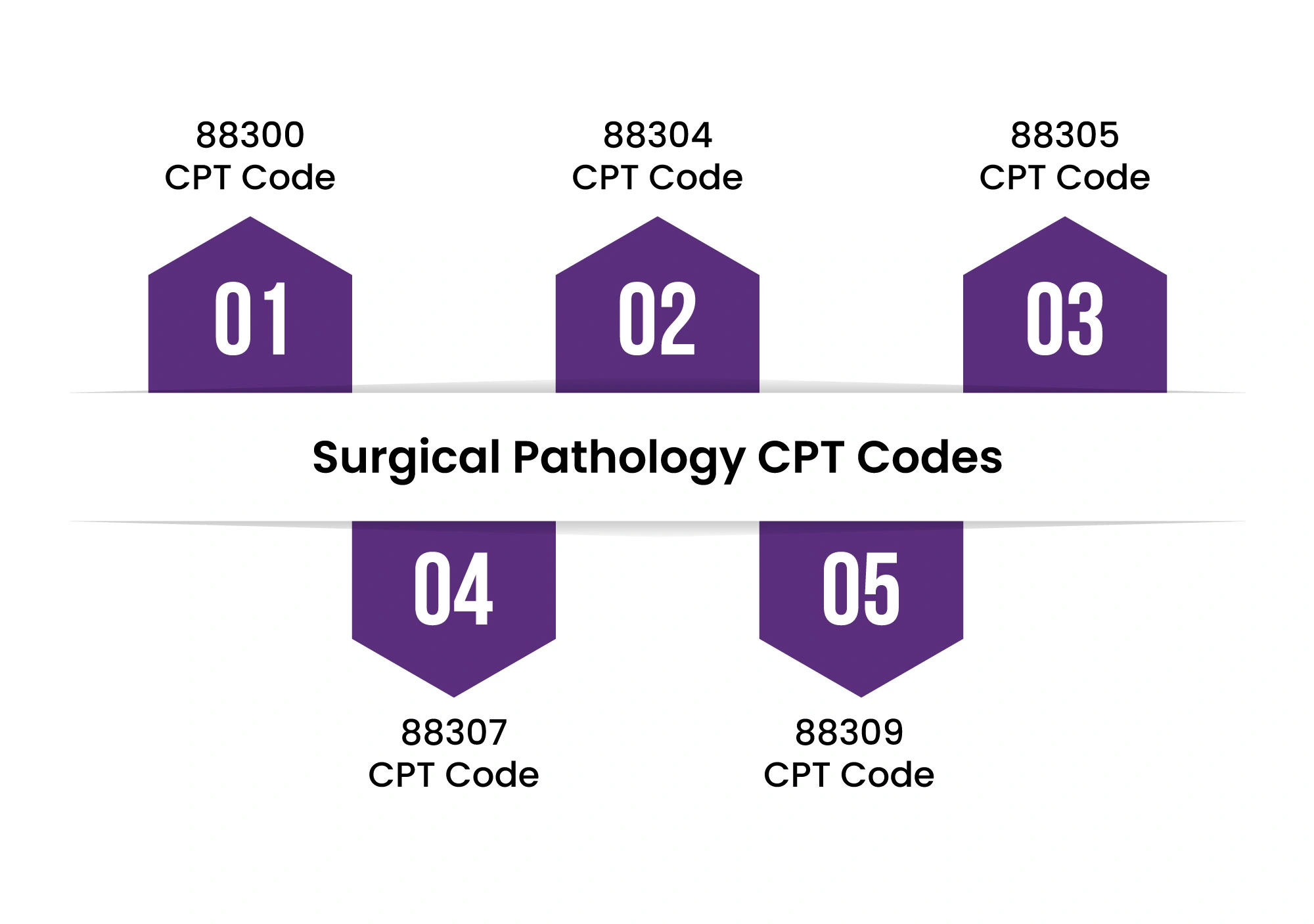
Common Surgical Pathology CPT Codes
-
88300 CPT Code – Gross examination only (used for simple specimens like foreign bodies).
-
88304 CPT Code – Gross and microscopic examination for minor specimens (e.g., skin tags, cysts).
-
88305 CPT Code – Intermediate-level tissue examination (e.g., cervical biopsies, polyps).
-
88307 CPT Code – Detailed examination of complex specimens (e.g., myocardium biopsy).
-
88309 CPT Code – Highest complexity level for major surgical resections (e.g., tumor excisions).
Why It Matters?
These anatomic pathology CPT codes directly impact pathologists, hospitals, and laboratories, ensuring that each level of service is billed correctly for proper reimbursement. Using an incorrect code could mean losing hundreds—or even thousands—of dollars per claim.
2. Special Stains and Procedures
Histopathology often requires special stains to identify microorganisms, enzymes, and cellular structures. These stains help pathologists diagnose infections, tumors, and tissue abnormalities.
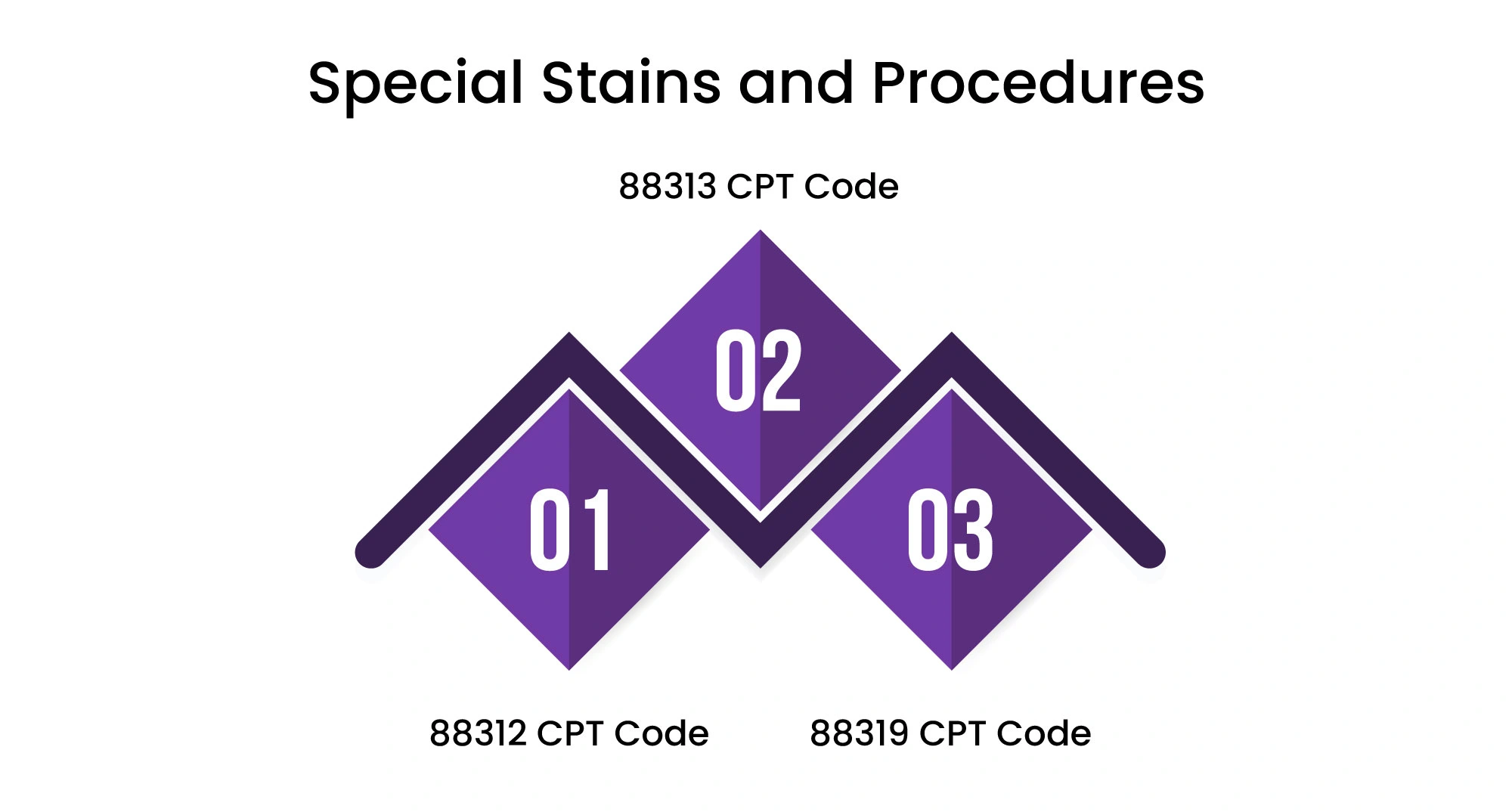
Common Special Stains CPT Codes
-
88312 CPT Code – Special stains for microorganisms (e.g., detecting bacteria or fungi in tissue samples).
-
88313 CPT Code – Histochemical staining for cellular structure visualization.
-
88319 CPT Code – Advanced cytochemical/histochemical stains for enzyme detection.
Why It Matters?
Special stains enhance diagnostic precision, allowing pathologists to accurately interpret disease markers. Proper coding ensures appropriate reimbursement for additional staining techniques used in diagnostics.
3. Immunohistochemistry & Electron Microscopy
Immunohistochemistry (IHC) and electron microscopy are advanced diagnostic techniques used for cancer diagnosis, biomarker identification, and ultrastructural analysis. These tests provide molecular-level insights, crucial for personalized treatment plans.
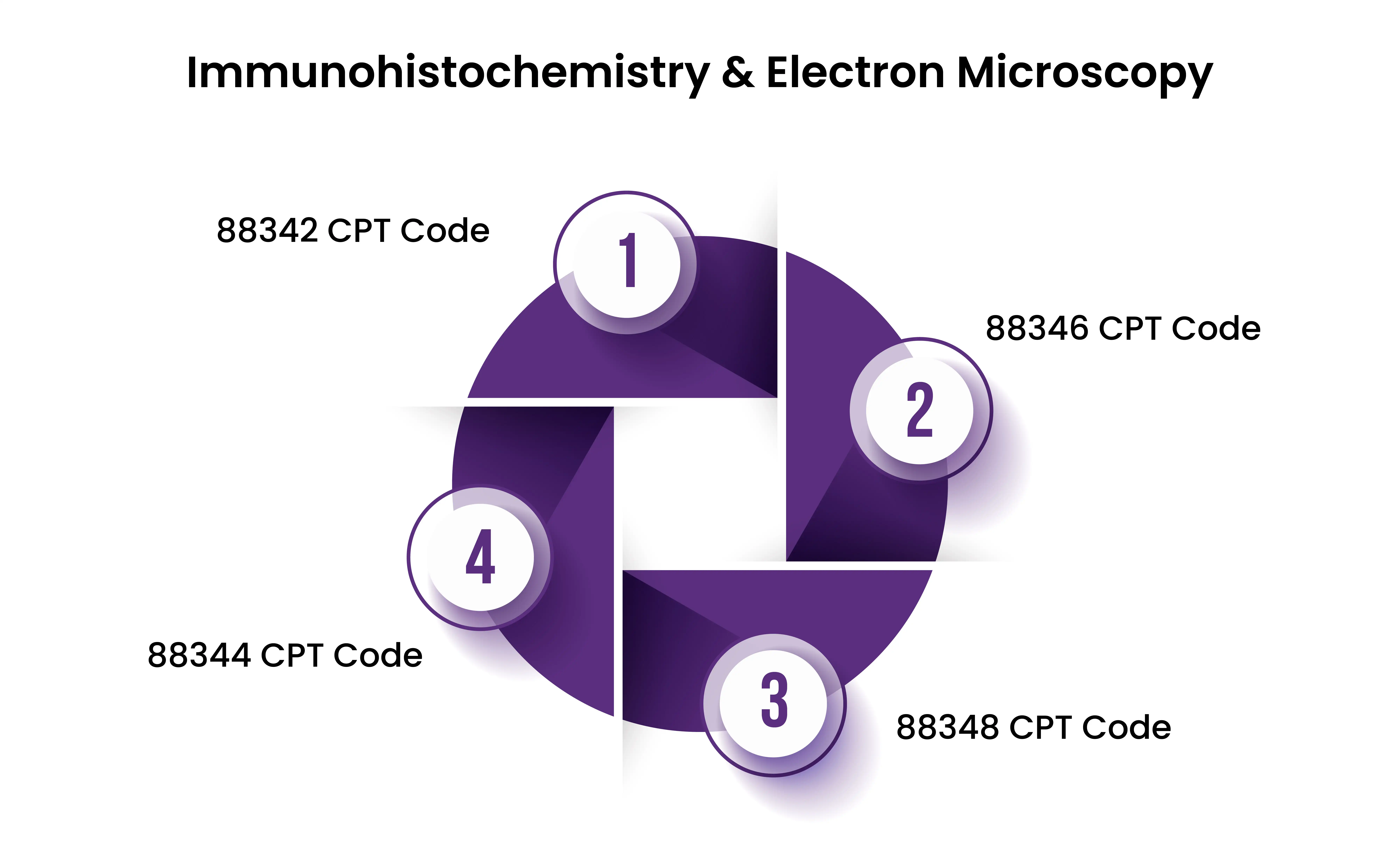
Key CPT Codes for IHC & Electron Microscopy
-
88342 CPT Code – IHC for detecting specific antigens using a single antibody.
-
88344 CPT Code – Multiplex IHC for analyzing multiple markers in a single sample.
-
88346 CPT Code – Immunofluorescent studies for targeted antigen detection.
-
88348 CPT Code – Electron microscopy for high-resolution cellular examination.
Why It Matters?
These digital pathology CPT codes are critical in oncology and molecular diagnostics. Proper coding ensures laboratories are compensated for the use of advanced imaging and diagnostic techniques.
4. Cytopathology CPT Codes
Cytopathology focuses on analyzing individual cells for cancer detection, infections, and other abnormalities. These tests are widely used for Pap smears, fine-needle aspiration (FNA) biopsies, and fluid cytology.
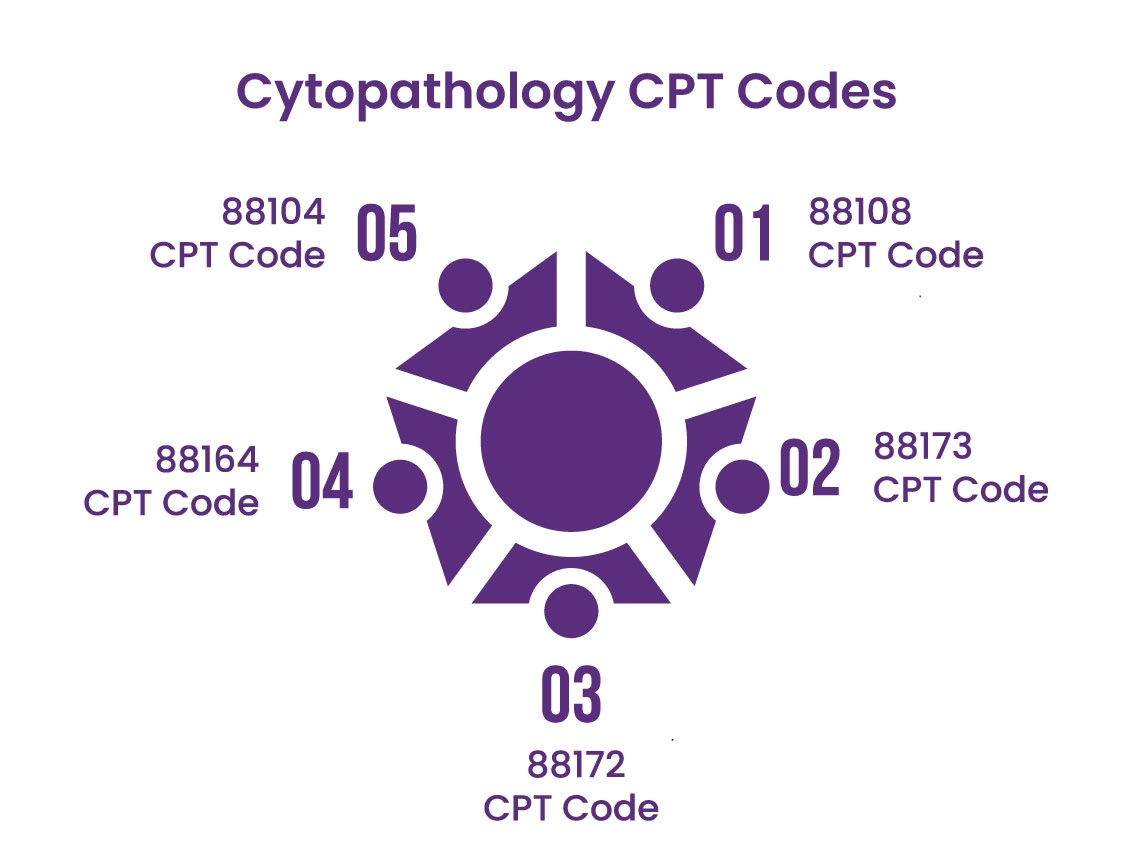
Frequently Used Cytopathology CPT Codes
-
88104 CPT Code – Cytological evaluation of fluids (e.g., peritoneal, pleural fluids).
-
88108 CPT Code – Concentration techniques for sample preparation (e.g., Saccomanno technique).
-
88164 CPT Code – Manual Pap smear screening (cervical/vaginal cytology).
-
88172 CPT Code – Immediate evaluation of FNA biopsies.
-
88173 CPT Code – Full diagnostic FNA specimen interpretation.
Why It Matters?
Cytopathology CPT codes are crucial for early cancer detection and disease monitoring. Proper documentation of these codes ensures full reimbursement for laboratory and pathology services.
5. Molecular Pathology CPT Codes
Molecular pathology is revolutionizing genetic testing, personalized medicine, and targeted therapies. These CPT codes cover DNA, RNA, and biomarker testing for disease identification and risk assessment.
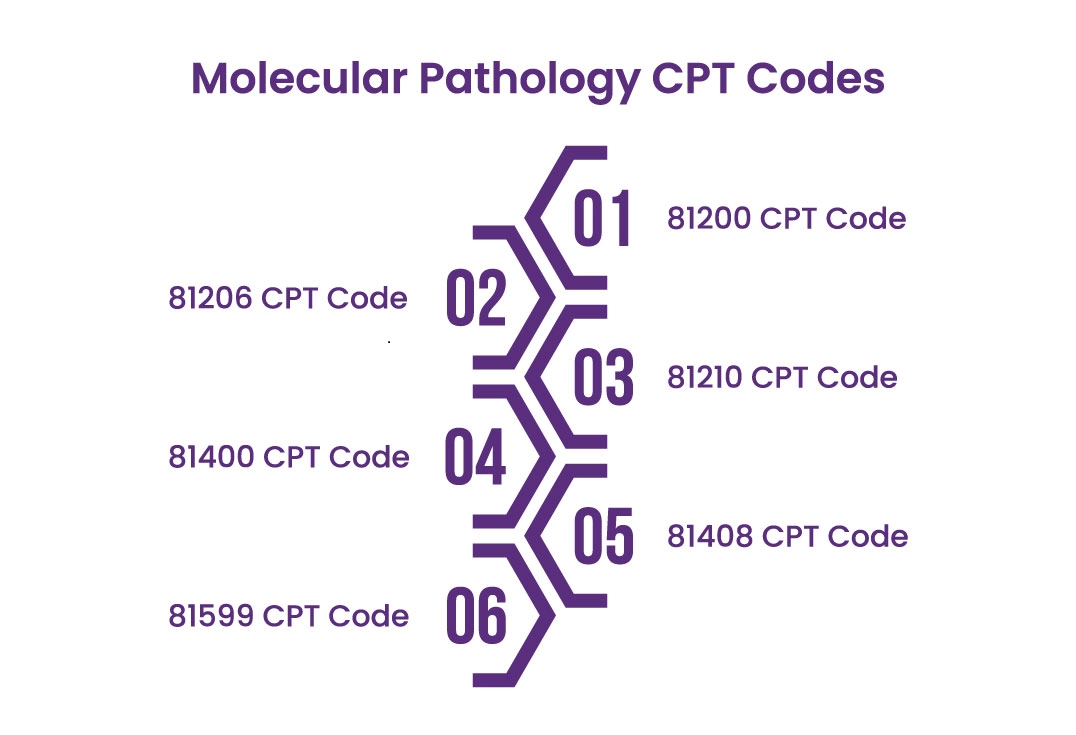
Important Molecular Pathology CPT Codes
-
81200 CPT Code – Basic molecular diagnostic procedures.
-
81206 CPT Code – BCR/ABL1 gene analysis (important in leukemia diagnosis).
-
81210 CPT Code – BRAF mutation testing for melanoma treatment decisions.
-
81400 CPT Code – Level 1 molecular pathology analysis.
-
81408 CPT Code – Highly complex Level 9 genetic testing.
-
81599 CPT Code – Multianalyte assays with algorithmic analysis.
Why It Matters?
These molecular pathology CPT codes are crucial for genomic research and personalized medicine. Proper coding ensures maximum reimbursement for genetic testing labs and biotech companies.
6. Anatomic Pathology Consultation Codes
Anatomic pathology consultation services involve reviewing and analyzing tissue specimens referred by other providers. These consultations are crucial for second opinions, complex case evaluations, and specialized pathology insights.
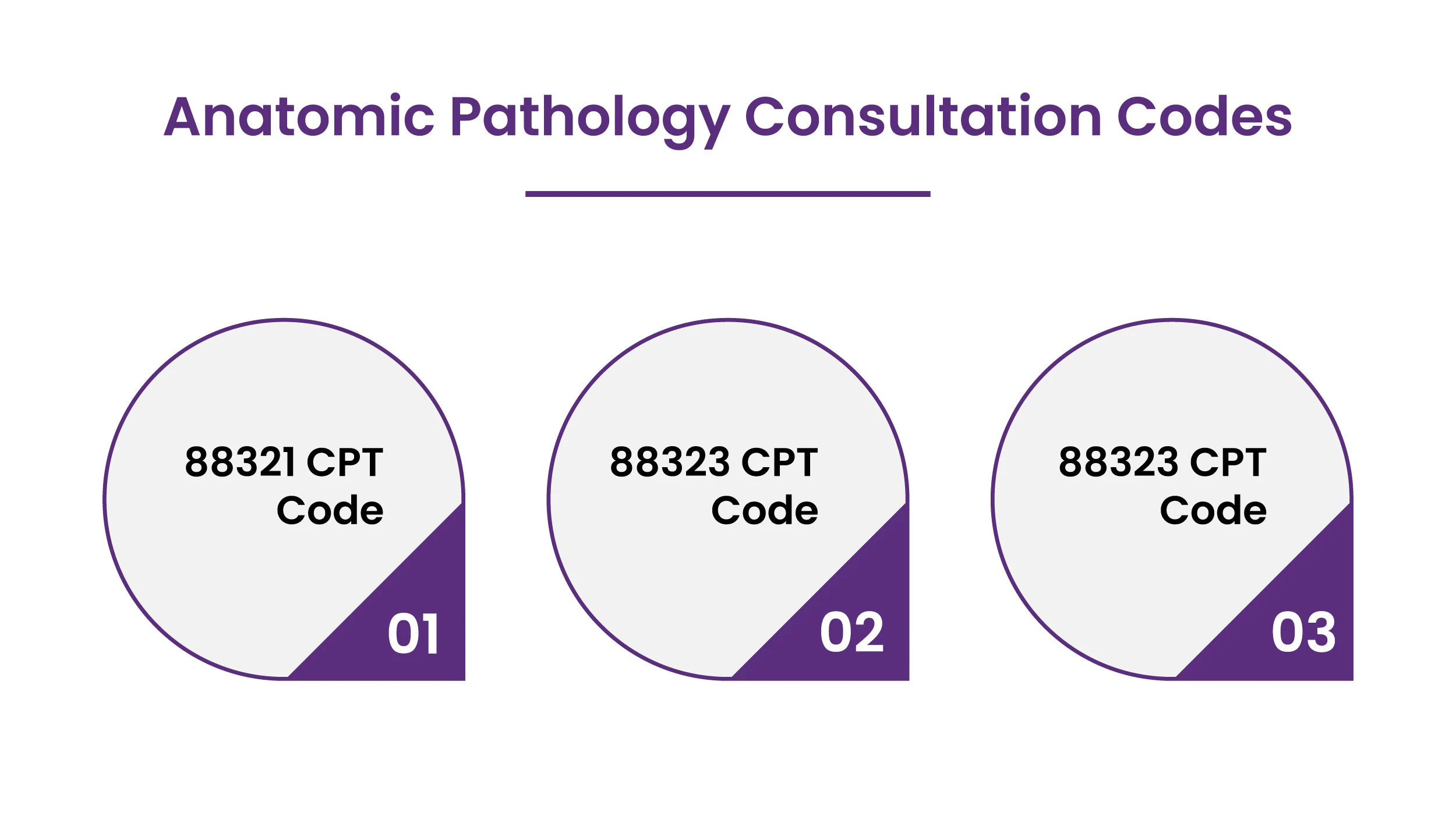
Common Anatomic Pathology Consultation CPT Codes
-
88321 CPT Code – Consultation and report based on slides prepared elsewhere.
-
88323 CPT Code – Consultation requiring new slide preparation from the referred material.
-
88325 CPT Code – Comprehensive review and report, including records, slides, and additional tests.
Why It Matters?
Consultation codes are vital for diagnostic accuracy and patient care. Medical specialists, oncologists, and hospitals often rely on anatomic pathology consultations for complex cases. Proper coding ensures fair reimbursement for expert pathology reviews.
7. Speech Pathology CPT Codes
Speech pathology CPT codes are used for assessing, diagnosing, and treating speech, language, and swallowing disorders. These codes are essential for speech therapists, hospitals, and outpatient rehabilitation clinics.
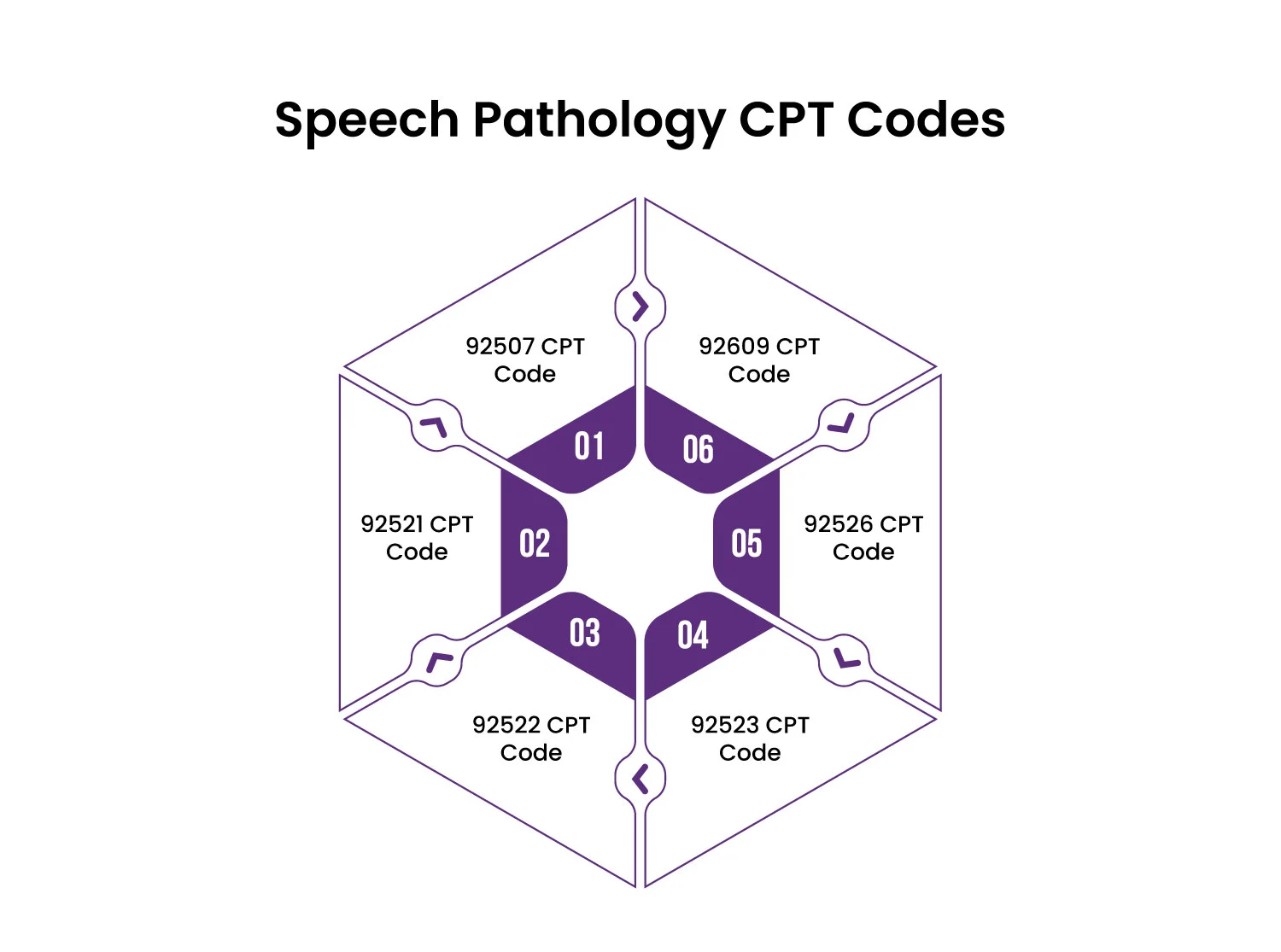
Most Common Speech Pathology CPT Codes
-
92507 CPT Code – Speech and language therapy for communication disorders.
-
92521 CPT Code – Fluency evaluation for stuttering or cluttering disorders.
-
92522 CPT Code – Evaluation of speech sound production (e.g., articulation issues).
-
92523 CPT Code – Combined evaluation of speech and language comprehension.
-
92526 CPT Code – Treatment for swallowing dysfunction (e.g., dysphagia therapy).
-
92609 CPT Code – Therapy for speech-generating devices (e.g., assistive communication).
Why It Matters?
Speech therapy services must be coded accurately for insurance claims and reimbursement approvals. These speech pathology CPT codes ensure providers receive fair payment for their therapeutic interventions.
8. Pathology CPT Code Ranges Overview
Pathology and laboratory CPT codes are categorized into different levels, depending on the type and complexity of the test. Below is an overview of the main CPT code tiers:
Tier-Based Pathology CPT Code Classification
Tier 1 (80000-89398): Covers general laboratory tests, including chemistry, hematology, and microbiology. These tests are routine lab procedures used for medical diagnoses.
Tier 2 (89399-89999): Includes specialized or less common pathology procedures, such as tissue cultures, uncommon diagnostic tests, and specialized analyses.
Tier 3 (90000-99000): Reserved for clinical diagnostic testing, molecular diagnostics, and cytogenetics. These tests involve genomic analysis, precision medicine, and high-complexity lab work.
Why It Matters?
Pathology CPT code ranges help categorize medical services, ensuring billing accuracy and proper reimbursement. Understanding these tiers helps laboratories, hospitals, and pathology specialists navigate medical billing efficiently.
Conclusion
Are incorrect CPT codes causing claim denials, delayed payments, and lost revenue? In the complex world of medical billing, accuracy is everything. Pathology CPT codes ensure that every diagnostic test, tissue analysis, and molecular examination is properly reimbursed, avoiding financial losses and compliance issues.
By mastering surgical pathology, molecular pathology, and speech pathology CPT codes, healthcare providers can:
-
Ensure every service is billed correctly and fully compensated.
-
Avoid common coding errors that lead to insurance rejections.
-
Adhere to medical coding regulations to prevent audits and penalties.
-
Streamline medical billing processes for faster payments.
Billing mistakes can be costly, but with the right knowledge and expert support, you can eliminate errors, improve cash flow, and ensure accurate reimbursements. If you need expert assistance with pathology billing services, check out HCMS Pathology Billing Services.
Don’t let incorrect coding hold your practice back—stay informed, get reimbursed, and take control of your billing success today!
FAQs
Q1: What is the pathology CPT code range?
Ans: Pathology CPT codes fall within the 80000–89999 range, covering clinical lab tests, pathology services, and molecular diagnostics.
Q2: How do anatomic pathology CPT codes differ from molecular pathology CPT codes?
Ans: Anatomic pathology CPT codes (88300–88399) focus on tissue analysis and microscopic exams, while molecular pathology CPT codes (81105–81599) cover genetic and biomarker testing.
Q3: What are the most commonly used lab CPT codes?
Ans: Common lab CPT codes include those for blood tests, biopsies, microbiology tests, and genetic screenings.
Q4: Why is it important to use the correct pathology CPT code?
Ans: Using the correct pathology CPT code ensures accurate billing, prevents claim denials, and guarantees full reimbursement for services provided.
Q5: What CPT codes do speech pathologists use?
Ans: Speech pathology CPT codes (92507–92610) cover speech therapy, voice assessments, and swallowing function evaluations.
ABOUT AUTHOR

Michael Carter
I’m Dr. Michael Carter, a Pathologist with years of experience in diagnostic medicine. While my focus is on patient diagnostics, I’ve also worked closely with billing and coding teams to ensure accurate documentation and reimbursement for pathology services. I understand the importance of proper coding in healthcare, and through my writing, I aim to share practical insights that help both clinicians and administrative professionals navigate the billing and coding process more effectively.
